 Roman Coins with Fortuna
Roman Coins with Fortunafrom the First Tetrarchy at the end of the third century AD
and others from earlier.
 Roman Coins with Fortuna
Roman Coins with Fortuna
from the First Tetrarchy at the end of the third century AD
and others from earlier.
What's new? 2025, May 30. A provincial coin with legend including the word "FORTVNA".
2025, March 26: The return to Rome of Septimius Severus in 202.
2025, Jan. 4: A Roman provincial coin of Commodus.
2024, Feb. 16: Faustina II with a unique type "FORTVNAE MVLIEBRI".
A standing Fortuna of Constantius.
All images now linked to larger versions. Click on the image to see it larger.
2022, Nov. 1: Gallienus with Fortuna standing and rudder.
Fortuna was the Italian goddess of chance or luck in the sense of good fortune, bad fortune, and the future. She contributes to steering the course of events, hence the rudder. Good fortune brings abundance, hence the cornucopia. Our terms "fortunate" and "fortune teller" derive from Fortuna. One aspect pertained to fortune in battle. Fortuna REDVX is her aspect relating to a safe return from trips.
(This page begins with the series under the First Tetrarchy. The second half of this page illustrates FORTVNA coins from earlier. Click the images to see enlarged images.)
Fortuna folles under the tetrarchy (For earlier FORTVNA coins, see below)
• are only from Trier
• are issued in the names of each of the four tetrarchs
• have two types, both with Fortuna left holding rudder and cornucopia:
Fortuna standing
Fortuna seated
• have three reverse legends:
FORTVNAE REDVCI AVGG NN,
FORTVNAE REDVCI CAES NN, or
FORTVNAE REDVCI AVGG ET CAESS NN.
• have reverse legends in plural, indicated by the doubled letters "G" and "S" and "N". "N" is "noster" = "of our" "AVGG NN" = "of our Augusti," which emphasizes the unity of the college of emperors. Some were away and would hopefully return safely.
The Four Tetrarchs.
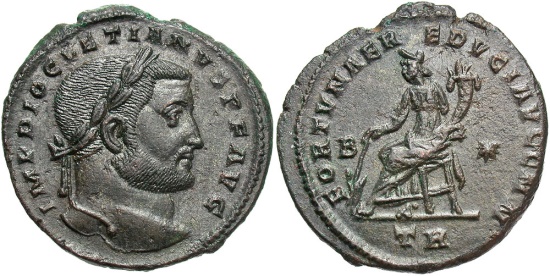
Diocletian, Augustus 284-305 AD
IMP DIOCLETIANVS PF AVG
28 mm. 8.88 grams. 12:00 die axis.
FORTVNAE REDVCI AVGG NN
Fortuna seated left holding rudder and cornucopia.
B in left field, * in right field, TR in exergue.
Struck at Trier (Treveri) [Now in Germany]
c. 298-299 AD.
RIC Trier 230a.
Failmezger 2.
The Greek "Tyche" is a similar goddess considered the eastern Greek equivalent of Fortuna. Many Roman provincial coins from eastern Greek cities illustrate the Tyche of the city with a turretted head. However, they do not name "Tyche" the way many Roman coins name Fortuna.
The coins on this page are of the large "follis" denomination which succeeded the "radiate" or "antoninianus" (a.k.a. "aurelianus") denomination in Diocletian's coin reform of 294 AD.
The type was issued for the four emperors of the first tetrarchy: Diocletian and Maximian as Augusti, and Constantius and Galerius as Caesars. Unlike the common GENIO POPVLI ROMANI reverses which were issued at every mint, this issue was only at Trier. (Similar legends occurred on very rare gold of Trier and Antioch.) There are two main types, one with Fortuna seated as above and the other with Fortuna standing, as next.
 Galerius, Caesar 293 - 305 and Augustus 305 - 311.
Galerius, Caesar 293 - 305 and Augustus 305 - 311.
IMP MAXIMIANVS NOBIL CAESS
Laureate head right.
FORTVNAE REDVCI CAESS NN
Fortuna standing left, holding rudder and cornucopia, with globe at her feet.
* in field right. BTR in exergue.
30-27 mm. 9.97 grams. 6:00 die axis.
Stuck at Trier, c. 298-299.
RIC Trier 414b. Failmezer 4.
The first coin has legend with AVGG and this one with CAESS because Galerius was only Caesar at the time. The obverse legend names him "Maximianus," but, to distinguish him from the other Maximianus we call this emperor by one of his other names, Galerius (He was Caius Galerius Valerius Maximianus). The emperor we call "Maximianus" was Marcus Aurelius Valerius Maximianus. He was never Caesar. When Diocletian chose him for promotion in 286 he was immediately made Augustus. (This is often the easiest way to tell their coins apart. If it says MAXIMIANVS CAES you know it is not Maximianus; it must be Galerius.) Until 293 there were only two Augusti (Diocletian and Maximian) and the system was not yet the "tetrarchy." The two Caesars (Constantius and Galerius, completing the tetrarchy) were created at almost the same time as the coin reform that produced this "follis" denomination. The previous "radiate" or "antoninianus" denomination was replaced and exists for both Caesars, but is rare for them, which shows the coin reform was not long after they were promoted.
Here is a coin of Maximian:
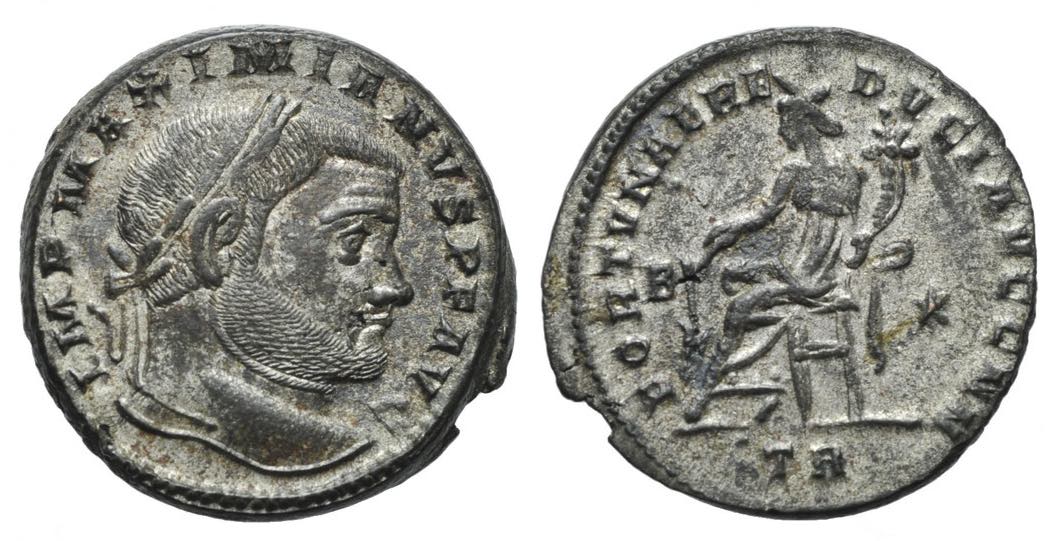 Maximian, Augustus 286-305
Maximian, Augustus 286-305
IMP MAXIMIANVS PF AVG
FORTVNAE REDVCI AVGG NN
Fortuna seated left, holding rudder and cornucopia
B in field left, * in field right. TR in exergue.
27-26 mm. 11.49 grams. 12:00 die axis.
Light surface silvering.
Struck at Trier, 298-299.
RIC Trier 230b.
Failmezger 2.
 Constantius I, Caesar 293-305 and Augustus 305-306
Constantius I, Caesar 293-305 and Augustus 305-306Fortuna Redux was the goddess of safe returns. Where were they returning from?
According to RIC, the first issue (distinguished by mintmark TR, as opposed to BTR or ATR) refers to
"Constantius' successful Rhenish campaigns" and possibly the conclusion of his British campaign in 296-297, and
"Heraclius' [Maximian's] African campaign (followed by his visit to Rome)" which followed his return from the Rhine (on his way to Africa).
All four tetrarchs were included in the very first issue, but another "return" could be celebrated as time went on:
"Galerius returning from Persia to Illyricum."
RIC does not note that Diocletian went to or came back from anywhere, but as a tetrarch he participates in the issue.
There are a large number of obverse legend and bust varieties. Most are not illustrated here. Here is one that is different in two regards.
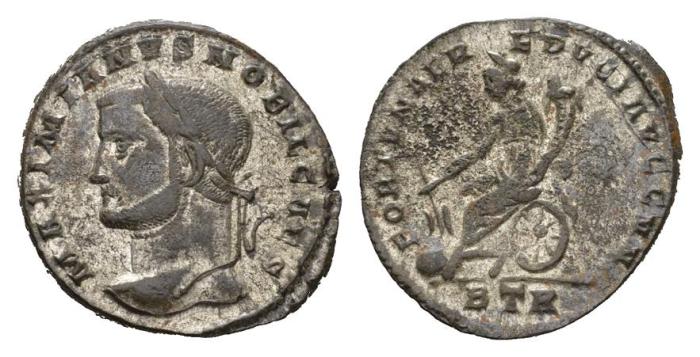 Galerius, Caesar 293 - 305 and Augustus 305 - 311.
Galerius, Caesar 293 - 305 and Augustus 305 - 311.
28-26 mm. 8.79 grams. 6:00 die axis.
MAXIMIANVS NOBIL CAES
Head left
FORTVNAE REDVCI AVGG NN
Fortuna seated left on wheel, holding rudder and cornucopia,
with globe at her feet.
No field marks, BTR in exergue.
Surface silvering.
Struck at Trier c.300-301
RIC Trier 392
Failmezger 2.

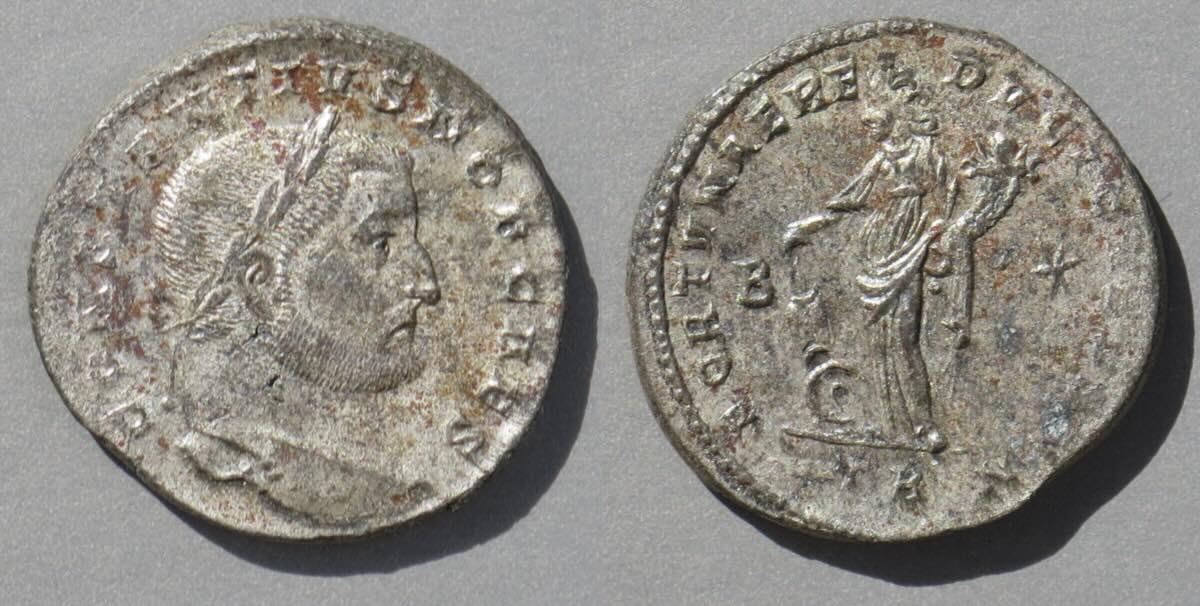 Constantius I, struck c. 298-299.
Constantius I, struck c. 298-299.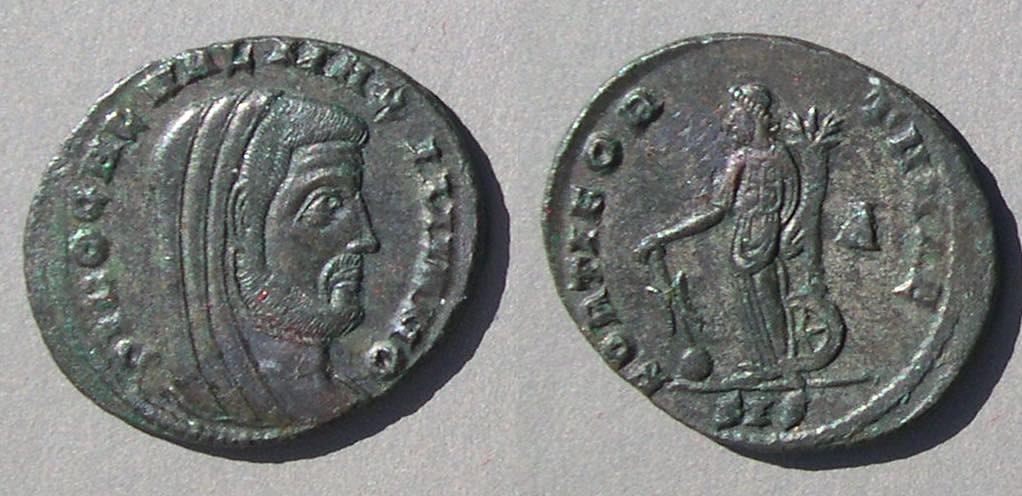 Divvs Galerius, struck by Licinius, late 311.
Divvs Galerius, struck by Licinius, late 311.
Comment for collectors: These Fortuna types are scarcer than generally acknowledged. RIC lists 89(!) varieties, almost all "S" for "scarce" or "R" for "rare" (RIC Trier 228-263 and 378-417, some with both a and b varieties). There are probably many more varieties; two are shown above. Failmezger considers the Fortuna type overall as "RR," very rare. I am inclined to call it rare overall. If there really were many "Scarce" varieties, Fortuna would appear on the market more often than it does. Those individual varieties are more likely "rare" or "very rare" and together they add up to "scarce." Collectors who see a list of 89 varieties imagine it is common and not worth as much as asked by dealers (who know that it should be worth more, but they can't make buyers buy). Therefore, it is not an extremely expensive type, although it is perhaps five times as expensive as a common GENIO POPVLI ROMANI in the same condition.
I think, but am not certain, the silvered ones above all came from one hoard disbursed beginning in 2013 (or earlier, and I don't know how many FORTVNA coins were in it).
Fortuna before the First Tetrarchy. Almost all emperors from Augustus through Severus Alexander (222-235) issued coins with Fortuna types [Gnecchi]. After that in the third century most did, but some emperors were too short-lived to get around to it. Here are a few examples.
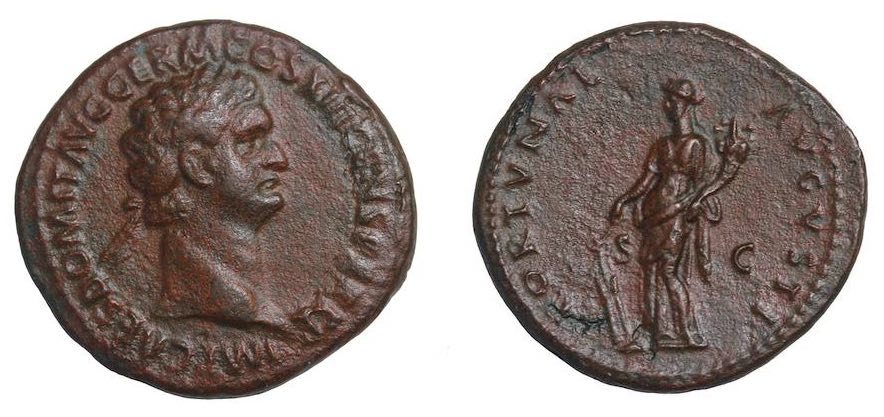
Domitian, 81-96
as. 28-27 mm. 9.56 grams.
IMP CAES DOMIT AVG GERM COS XIII CENS PER PP
Struck 86/7
FORTVNAE AVGVSTI
Fortuna standing holding rudder and cornucopia
RIC II.I 544. Sear I 2805v.
BMC [p. xcii] notes it refers to "The luck of the imperial family" and "may have some connection with the dedication of the temple of the gens Flavia." "Fortina was one of the deities who, under the Early Empire, enjoyed heart-felt worship. A world that was often in doubt of the divine providence felt the need to propitatate the power that could bring about the amazing vicissituds of fate which were characgeristic of the time." [p. xxxvii]
 Nerva, 96-98.
Nerva, 96-98.
18 mm. 3.40 grams.
IMP NERVA CAES AVG PM TRP COS III PP
FORTVNA PR, Fortuna seated left holding ears of grain and scepter
RIC 17. Sear II 3026. BMC 41.
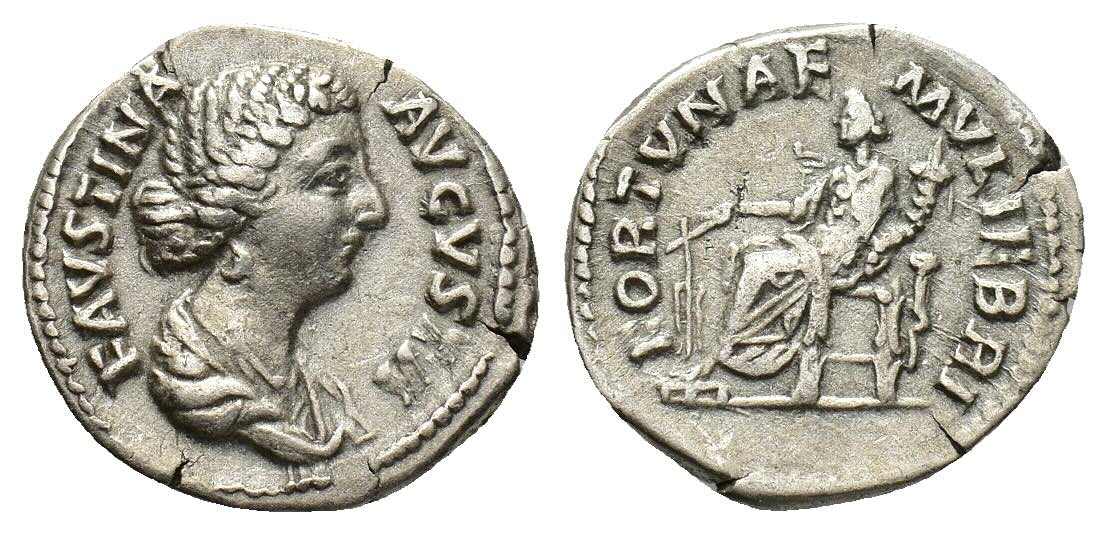 Faustina II, 148-175
Faustina II, 148-175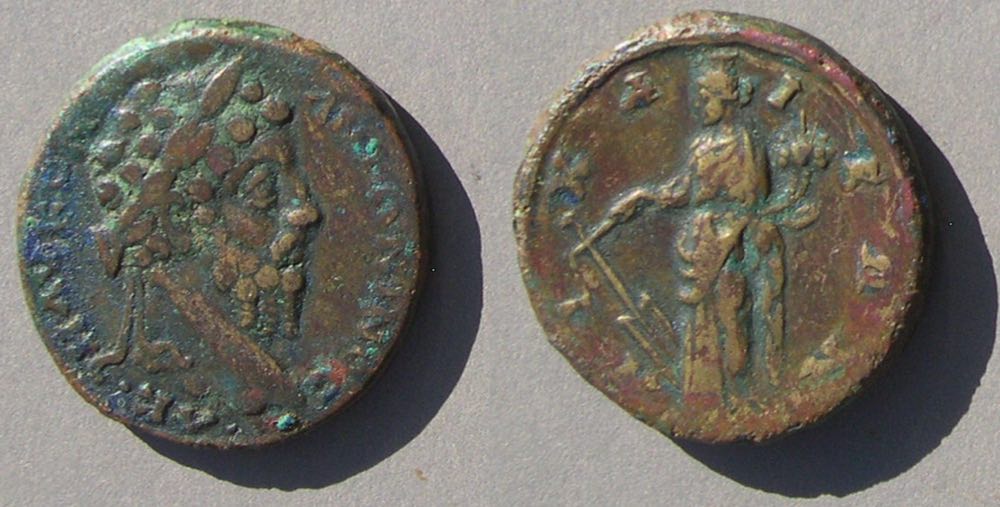 Commodus, 166-177-180-192.
Commodus, 166-177-180-192.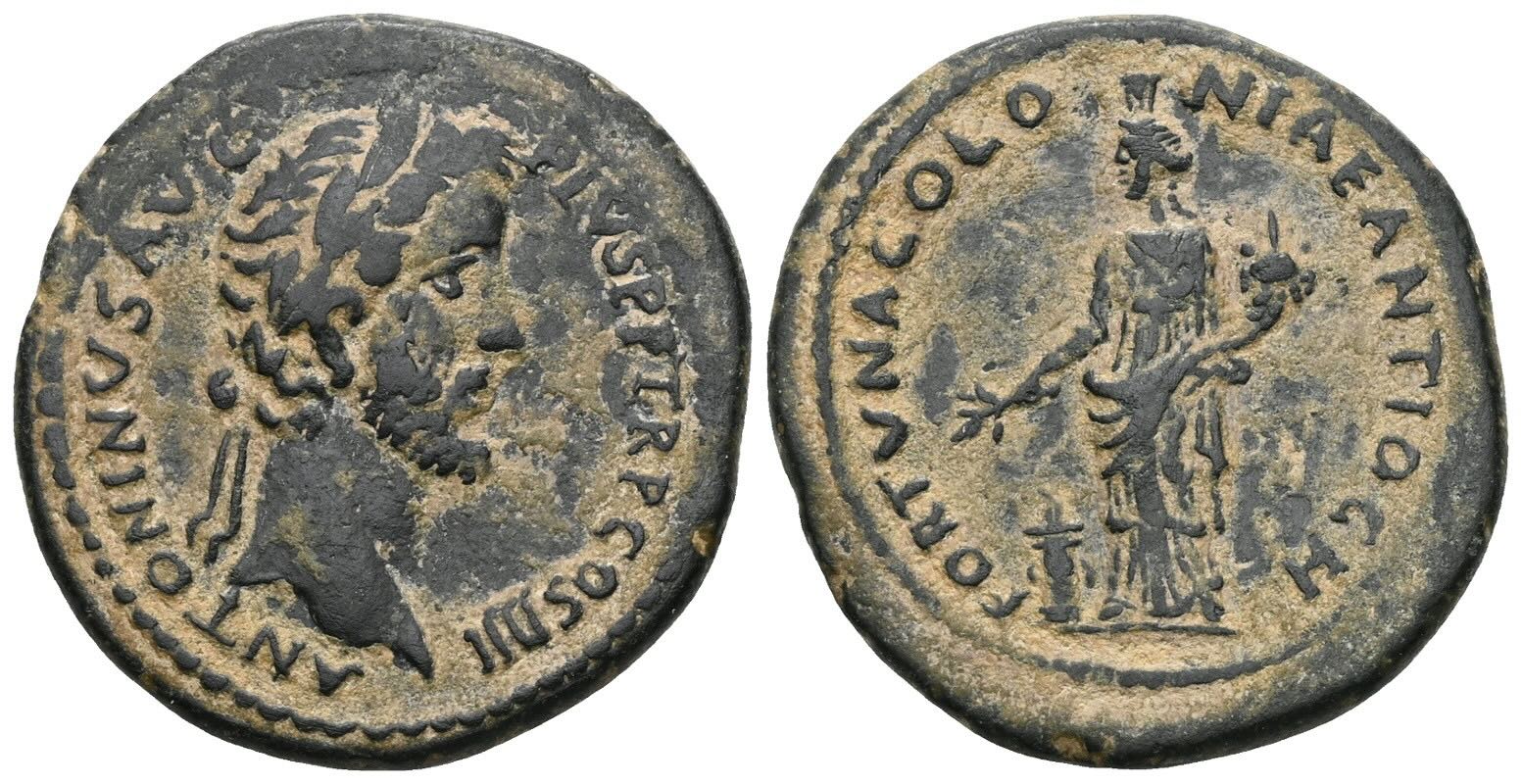
Antoninus Pius, 138-161.
25-24 mm.
Struck at Antioch in Pisidia.
Head right, laureate.
ANTONINVS AVG PIVS PP TRP COS IIII
(COS IIII dates it to 145 or later)
FORTVNA COLONIAE ANTIOCH
(Fortune of the colony of Antioch)
Fortuna standing left holding branch over altar, and cornucopia.
RPC IV.3 online 7328 (temporary), 4 pieces as of 5/28/2025. The main photo is of this coin.

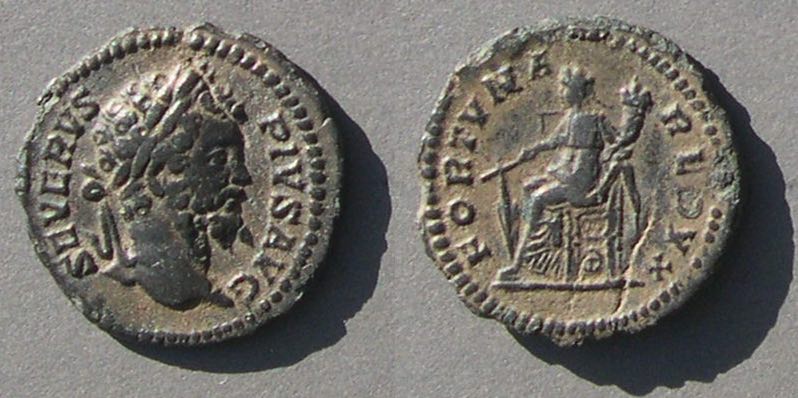 Septimius Severus, 193-211
Septimius Severus, 193-211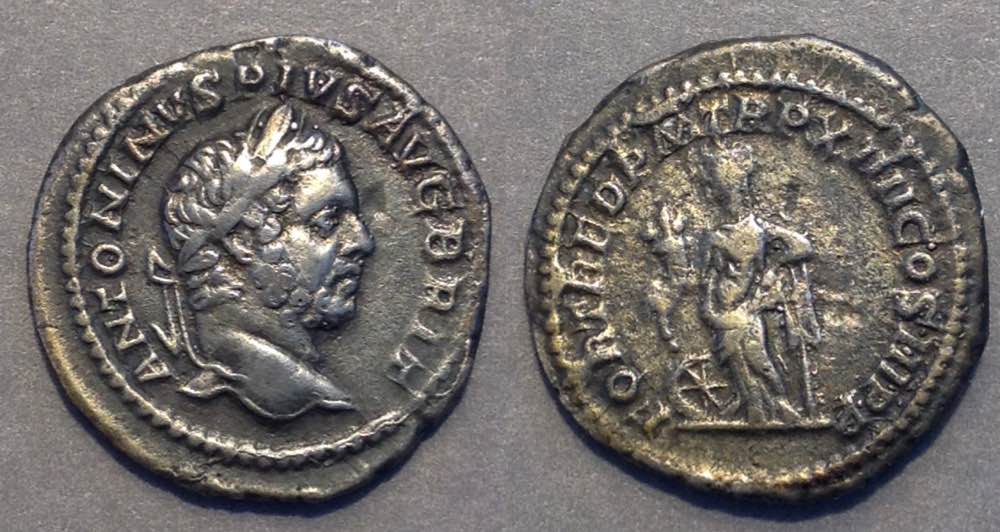 Caracalla, 198-217, during his joint reign with Geta, 211-212.
Caracalla, 198-217, during his joint reign with Geta, 211-212.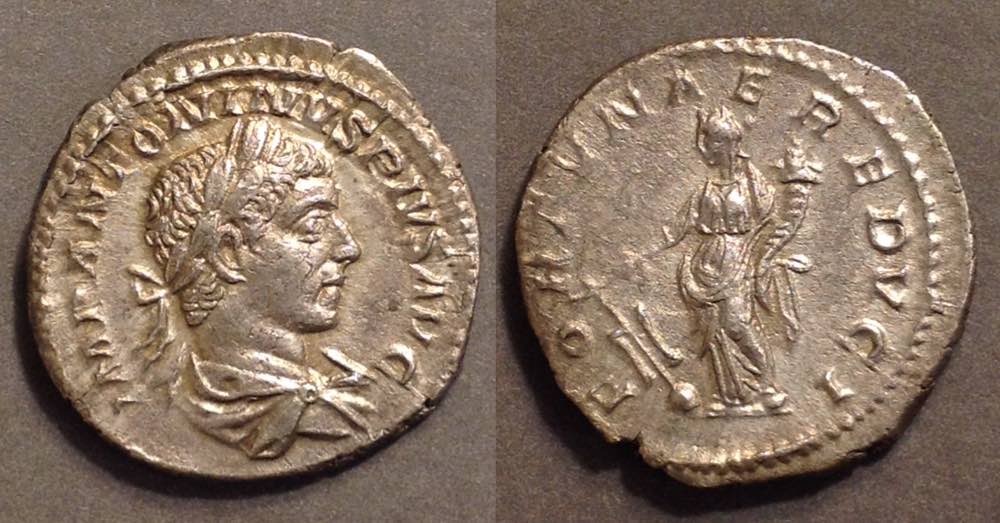
 Gordian III, 238-244
Gordian III, 238-244
Gallienus, 253-268
21 mm.
FORTVNA REDVX
Fortuna seated left holding rudder and cornucopia
RIC 484, Mediolanum. Sear III 10219.
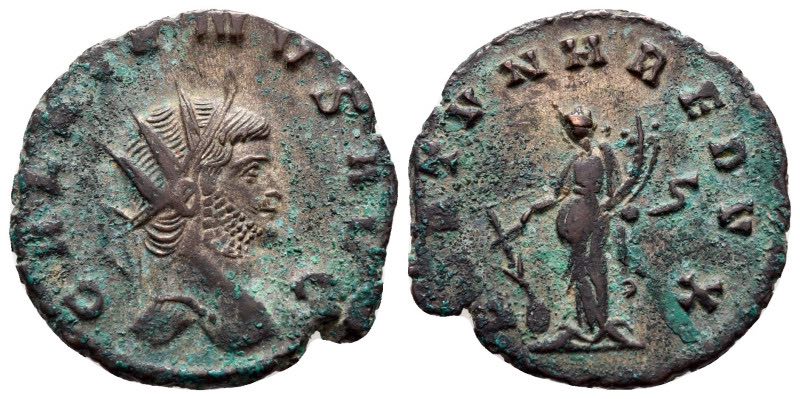

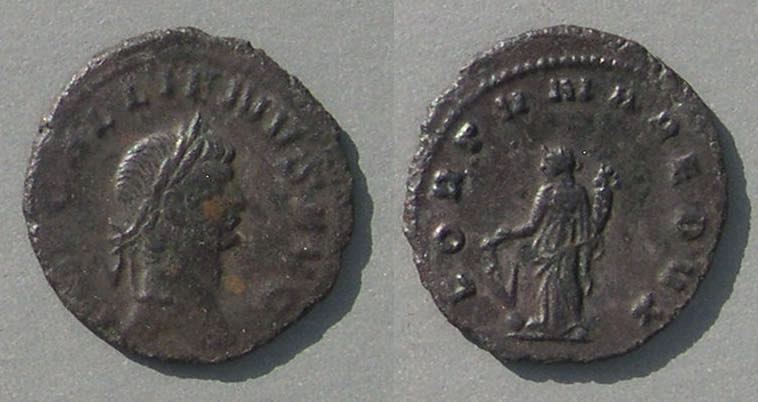
Gallienus, 253-268.
19 mm. A laureate denarius.
FORTVNA REDVX, Fortuna standing left holding rudder and cornucopia.
RIC 139 "quinarius". Sear 10431 "260-261"
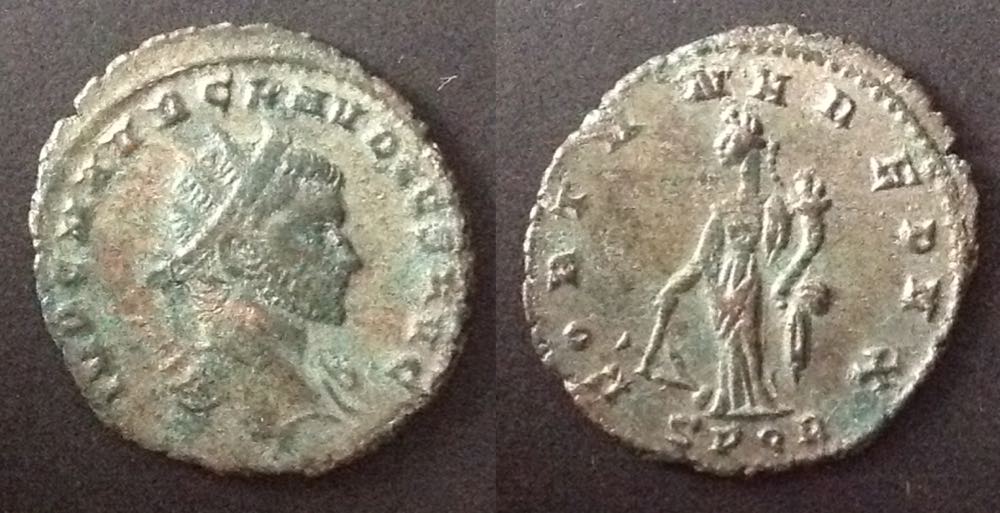

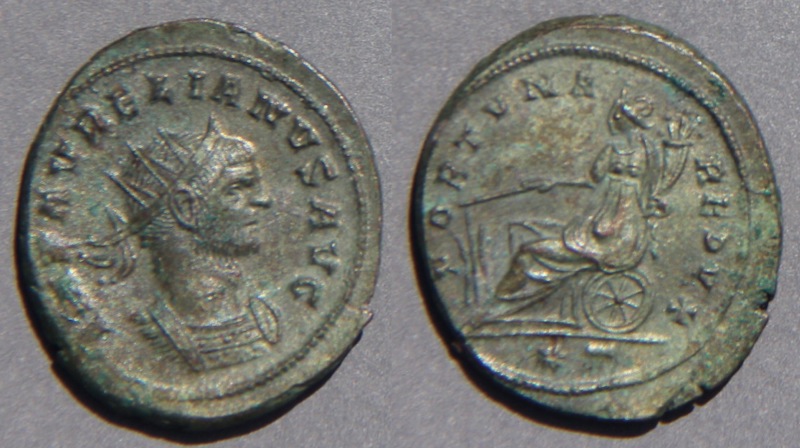
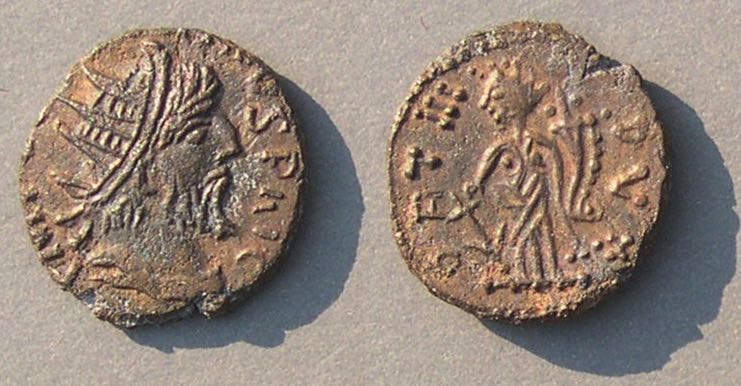 Victorinus, barbarous radiate, c. 269-271.
Victorinus, barbarous radiate, c. 269-271.References:
RIC = Roman Imperial Coinage, volume VI. 1973. (The standard reference for all post-Diocletian's-reform coins, 293-312)
Failmezger = Roman Bronze Coins from Paganism to Christianity, 294-364 AD, by Victor "Tory" Failmezger. 2002. Very well illustrarted. (Highly recommended for AE coins of this period.)
Foss, Clive. Roman Historical Coins. 1990. Hardcover. 335 pages. A list of all Roman coins that reference specific events, classified by year of the event. About 250 coins illustrated. If you want to collect types that connect to history, you will be happy with this book.
John Melville Jones, A Dictionary of Ancient Roman Coins. 1990. (Highly recommended for explaining all the words encountered in the study of ancient Roman coins.)
Gnecchi = Coin Types of Imperial Rome, by F. Gnecchi. 1908, reprinted. (Very old and not recommended. However, it does list in a big table which emperors issued coins with which personifications.)
If you want, contact me at

Return to the Table of Contents for this whole site.